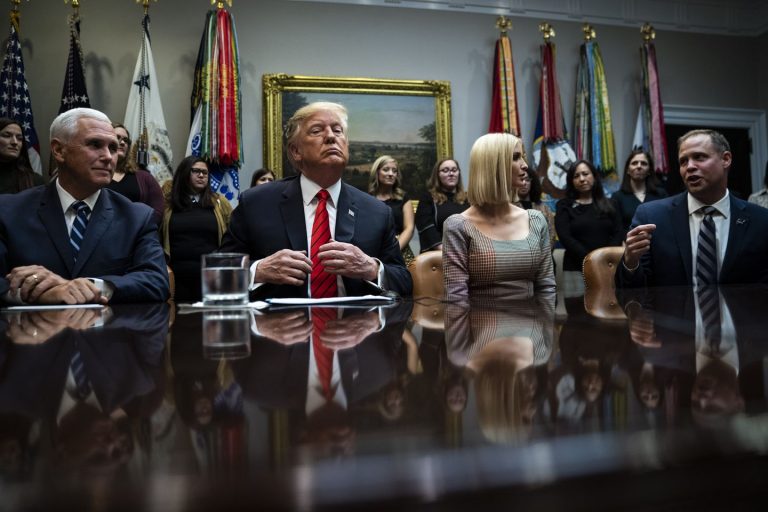

However on Monday the White Home proposed an bold plan that might give the house company important spending boosts over a number of years, stretching spending from about $19 billion when President Trump got here into workplace to $28.6 billion by fiscal 2023.
NASA officers additionally for the primary time offered a complete price for this system to land astronauts on the moon, often known as Artemis, putting it at $35 billion through 2024. Though the White Home’s objective nonetheless faces many important hurdles — in navigating each the vacuum of house and the equally treacherous halls of Congress — the stress is on NASA Administrator Jim Bridenstine, who stated throughout a speech Monday, “It’s as much as us to ship.”
House exploration has been a serious precedence for the Trump administration, which reconstituted the Nationwide House Council and directed NASA to dramatically velocity up its moon program. And it exhibits in its budget proposal, which Bridenstine referred to as “one of many strongest budgets in NASA historical past.”
The spending plan for subsequent yr requires a complete budget of $25.2 billion, an almost $Three billion enhance over the present $22.6 billion. The rise is step one towards assembly the White Home mandate to return people to the lunar floor by 2024 as a part of the Artemis program. The White Home plans to proceed the increases through fiscal 2023.
One of many subsequent huge steps is awarding the contract for a lunar lander system, which is predicted within the coming months. A number of corporations are vying for the contract, together with Boeing, SpaceX and a staff led by Jeff Bezos’s Blue Origin that features Lockheed Martin, Northrop Grumman and Draper. (Bezos owns The Washington Put up.)
For subsequent yr, the White Home plans embrace $3.four billion for a lunar lander system — “the primary time we’ve had direct funding for a human touchdown system since Apollo,” Bridenstine stated.
It additionally consists of practically $2.Three billion for the House Launch System rocket, being constructed largely by Boeing and Aerojet Rocketdyne, and $1.four billion for the Lockheed Martin-built Orion crew capsule. NASA plans to make use of these autos to get astronauts to the moon.
The SLS rocket has suffered a number of years of expensive setbacks and delays. However Monday, Bridenstine stated it had made important progress and referred to as it “America’s rocket” that can function the “basis of our 21st-century house exploration.”
Nonetheless, the budget request exhibits simply how costly the rocket is. The spending plan requires NASA to take a look at different commercially out there rockets to launch a mission as early as 2024 to discover Jupiter’s moon Europa. Doing so would save the company “over $1.5 billion in comparison with utilizing an SLS rocket,” the budget request says.
If all goes in line with plan, NASA’s Artemis program requires the primary launch of the SLS rocket with the Orion capsule for a mission across the moon with out crews in 2021. The next yr, astronauts could be on board Orion to orbit the moon, with the objective of touchdown on the floor by 2024.
As an alternative of going straight to the floor, nonetheless, the astronauts would first cease at an outpost often known as the Gateway in orbit across the moon. They might then fly to and from the lunar floor within the touchdown autos. The budget would allocate greater than $700 million for actions on the floor of the moon, corresponding to mining, which might permit astronauts to “stay off the land.”
This system, nonetheless, has met stiff resistance in Congress, particularly within the Democratic-controlled Home. Lately, the Home Science subcommittee on house and aeronautics voted out a invoice that directs NASA to land on the moon by 2028, not 2024, and spend most of its vitality and sources on a mission to place astronauts in orbit round Mars by 2033.
Members of Congress are more likely to be dismissive of provisions within the White Home budget that might minimize funding for the Vast Subject Infrared Survey Telescope (WFIRST), a key astrophysics mission for NASA. Previously, the White Home has tried to defund this system, solely to be reversed by Congress.
The White Home plan would additionally minimize funding for NASA’s Workplace of Science, Expertise, Engineering and Arithmetic (STEM) Engagement.
Sen. Jerry Moran (R-Kan.), the chairman of the Senate appropriations subcommittee that funds NASA, stated it was “encouraging to see a proposed budget that helps returning American astronauts to the moon. I stay wanting to obtain ample budget particulars to match our bold human exploration objectives.” He added that he was “dissatisfied the budget would minimize STEM schooling, which performs an important position in making sure we’ve got the expertise to realize our mission.”